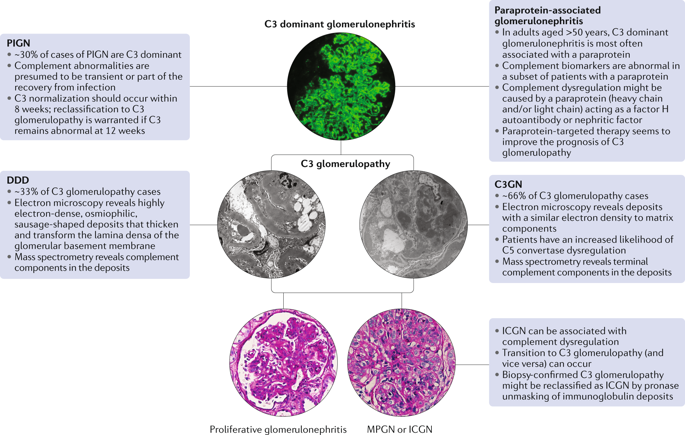当前位置:
X-MOL 学术
›
Nat. Rev. Nephrol.
›
论文详情
Our official English website, www.x-mol.net, welcomes your
feedback! (Note: you will need to create a separate account there.)
C3 glomerulopathy - understanding a rare complement-driven renal disease.
Nature Reviews Nephrology ( IF 28.6 ) Pub Date : 2019-03-01 , DOI: 10.1038/s41581-018-0107-2 Richard J H Smith 1 , Gerald B Appel 2 , Anna M Blom 3 , H Terence Cook 4 , Vivette D D'Agati 5 , Fadi Fakhouri 6 , Véronique Fremeaux-Bacchi 7 , Mihály Józsi 8 , David Kavanagh 9 , John D Lambris 10 , Marina Noris 11 , Matthew C Pickering 4 , Giuseppe Remuzzi 11, 12, 13 , Santiago Rodriguez de Córdoba 14 , Sanjeev Sethi 15 , Johan Van der Vlag 16 , Peter F Zipfel 17, 18 , Carla M Nester 1
Nature Reviews Nephrology ( IF 28.6 ) Pub Date : 2019-03-01 , DOI: 10.1038/s41581-018-0107-2 Richard J H Smith 1 , Gerald B Appel 2 , Anna M Blom 3 , H Terence Cook 4 , Vivette D D'Agati 5 , Fadi Fakhouri 6 , Véronique Fremeaux-Bacchi 7 , Mihály Józsi 8 , David Kavanagh 9 , John D Lambris 10 , Marina Noris 11 , Matthew C Pickering 4 , Giuseppe Remuzzi 11, 12, 13 , Santiago Rodriguez de Córdoba 14 , Sanjeev Sethi 15 , Johan Van der Vlag 16 , Peter F Zipfel 17, 18 , Carla M Nester 1
Affiliation

|
The C3 glomerulopathies are a group of rare kidney diseases characterized by complement dysregulation occurring in the fluid phase and in the glomerular microenvironment, which results in prominent complement C3 deposition in kidney biopsy samples. The two major subgroups of C3 glomerulopathy - dense deposit disease (DDD) and C3 glomerulonephritis (C3GN) - have overlapping clinical and pathological features suggestive of a disease continuum. Dysregulation of the complement alternative pathway is fundamental to the manifestations of C3 glomerulopathy, although terminal pathway dysregulation is also common. Disease is driven by acquired factors in most patients - namely, autoantibodies that target the C3 or C5 convertases. These autoantibodies drive complement dysregulation by increasing the half-life of these vital but normally short-lived enzymes. Genetic variation in complement-related genes is a less frequent cause. No disease-specific treatments are available, although immunosuppressive agents and terminal complement pathway blockers are helpful in some patients. Unfortunately, no treatment is universally effective or curative. In aggregate, the limited data on renal transplantation point to a high risk of disease recurrence (both DDD and C3GN) in allograft recipients. Clinical trials are underway to test the efficacy of several first-generation drugs that target the alternative complement pathway.
中文翻译:

C3 肾小球病 - 了解一种罕见的补体驱动的肾脏疾病。
C3 肾小球病是一组罕见的肾脏疾病,其特征是在液相和肾小球微环境中发生补体失调,导致肾活检样本中出现显着的补体 C3 沉积。C3 肾小球病的两个主要亚型——致密沉积病 (DDD) 和 C3 肾小球肾炎 (C3GN)——具有重叠的临床和病理特征,提示疾病连续体。补体替代途径失调是 C3 肾小球病表现的基础,尽管终末途径失调也很常见。大多数患者的疾病是由后天因素驱动的,即针对 C3 或 C5 转化酶的自身抗体。这些自身抗体通过延长这些重要但通常寿命较短的酶的半衰期来驱动补体失调。补体相关基因的遗传变异是一个不太常见的原因。尽管免疫抑制剂和末端补体途径阻断剂对某些患者有帮助,但尚无针对疾病的特异性治疗方法。不幸的是,没有一种治疗方法是普遍有效或治愈的。总的来说,肾移植的有限数据表明同种异体移植受者疾病复发(DDD 和 C3GN)的风险很高。临床试验正在进行中,以测试几种针对补体替代途径的第一代药物的功效。
更新日期:2019-05-16
中文翻译:

C3 肾小球病 - 了解一种罕见的补体驱动的肾脏疾病。
C3 肾小球病是一组罕见的肾脏疾病,其特征是在液相和肾小球微环境中发生补体失调,导致肾活检样本中出现显着的补体 C3 沉积。C3 肾小球病的两个主要亚型——致密沉积病 (DDD) 和 C3 肾小球肾炎 (C3GN)——具有重叠的临床和病理特征,提示疾病连续体。补体替代途径失调是 C3 肾小球病表现的基础,尽管终末途径失调也很常见。大多数患者的疾病是由后天因素驱动的,即针对 C3 或 C5 转化酶的自身抗体。这些自身抗体通过延长这些重要但通常寿命较短的酶的半衰期来驱动补体失调。补体相关基因的遗传变异是一个不太常见的原因。尽管免疫抑制剂和末端补体途径阻断剂对某些患者有帮助,但尚无针对疾病的特异性治疗方法。不幸的是,没有一种治疗方法是普遍有效或治愈的。总的来说,肾移植的有限数据表明同种异体移植受者疾病复发(DDD 和 C3GN)的风险很高。临床试验正在进行中,以测试几种针对补体替代途径的第一代药物的功效。





















































 京公网安备 11010802027423号
京公网安备 11010802027423号